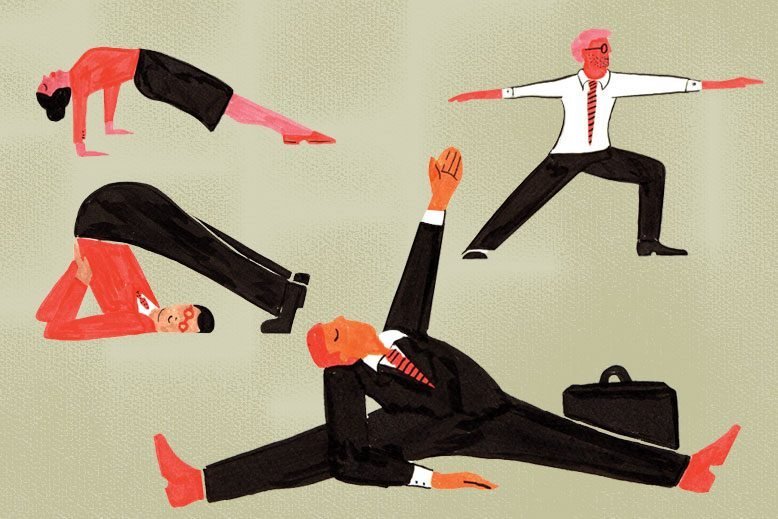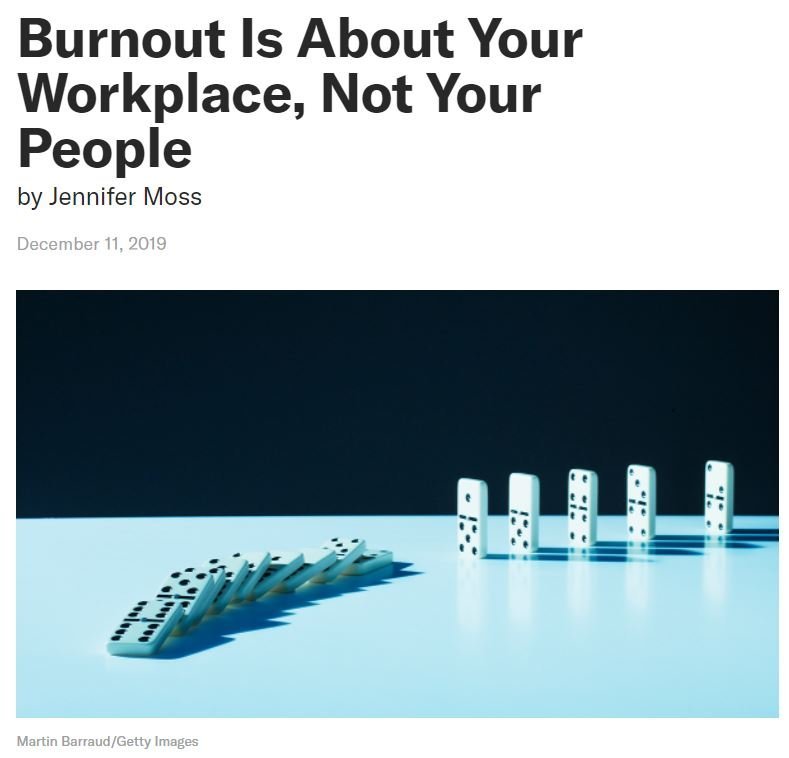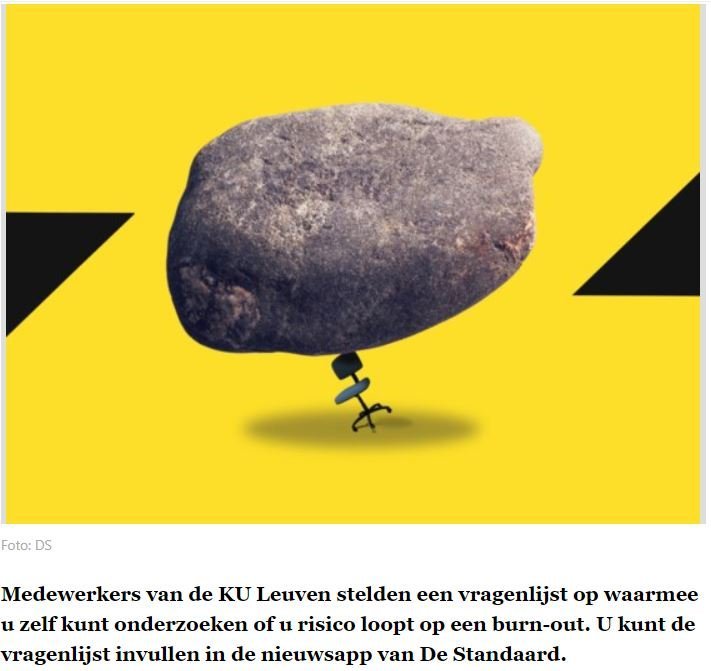
Statement
The same day, a statement-reaction on LinkedIn catches our eye. Someone posts "Burnout is about your workplace, not your people".
Author and author Jennifer Moss concludes from Stanford and American Psychiatric Association studies that companies without systems to support their employees' well-being have higher turnover, lower productivity and higher healthcare costs. In US companies with high workloads, healthcare costs are 50% higher than in other organisations.
So is she saying that it is not (only) because of the non-demanding but over-demanding employee and pointing the finger at the employers?
Burnout pandemic: sensational news or reality?
Since 2017, the national health insurance fund has been keeping more detailed records of the problems faced by long-term sick employees. Burnouts have increased by about 160 percent in less than three years, from 3,713 at the end of 2017 to 9,708 in June 2020.
Can burnouts be counted reliably? Since the World Health Organisation incorporated the concept into the International Classification of Diseases (ICD-11) two years ago, yes.
This list, revised after 30 years, came into force on 1 January 2022. All diseases are given a code with which doctors can register their diagnoses.
However, the WHO immediately added an urgent clarification: "Burnout is included in the 11th revision of the International Classification of Diseases (ICD-11) as an occupational phenomenon, not as a medical condition. Reasons why people contact health services, but which are not classified as diseases or health conditions." Why this somewhat confusing message?
According to the September 2017 opinion of the Supreme Health Council, the prevention of burnout is inevitably linked to the organisation of our work: towards a more sustainable and workable model rather than a performance- and efficiency-oriented one.
Very recent Flemish figures are not available, but given the rising trend in recent years, the number of people sitting at home with burnout complaints has probably never been so high.
"An energy disease"
Media testimonies give burnout a face and get more understanding reactions than before. People post their own stories in which "back to work after six weeks", as corona commissioner Facon did, is certainly not the general tenor.
The phenomenon of burnout has become a household word, but what it really means can only be told by patients themselves or by specialists in the field.
Dr. Luc Swinnen, for example, was an insurance doctor who immersed himself in burnout and stress field more than 20 years ago. In the present time, he coaches individuals but also measures stress in companies and draws up an action plan for them.
Burnout, he explains, is always announced by a series of four signals: physical complaints without an identifiable cause, overwhelming anger and/or fear reactions, loss of competence (forgetting things or making mistakes) and, finally, a change in behaviour in which, according to others, someone is "no longer himself".
If you ignore these signals, you can "suddenly" get the hammer blow and stop functioning. Since burnout is an energy disease, the antidepressants that are often prescribed do not get the patient back on his feet just like that.
Recovery is certainly possible, but the course is erratic and the duration difficult to estimate. That is also why prevention is better than cure.
"A burn-out risk analysis? That will probably cost a lot and is not necessary here anyway."
If management speaks this language, it is an alarm signal for an increased burnout risk among employees. Just like little autonomy, lower levels of involvement, a negative reporting culture, etc.
If very enthusiastic employees find themselves in such an environment, they are more likely to suffer from burnout.
In organisations that take targeted action, Dr. Swinnen says, working conditions improve, leading to more efficient work and greater job satisfaction. Key conditions for a living safety culture, by the way, and thus more constant or even higher productivity.
Allergic to yoga
Jennifer Moss, in "Burnout is about your workplace, not your people", goes a step further by separating burnout from individual vulnerabilities such as high motivation, perfectionism, all of which can be solved by "simply learning to say no". She is equally allergic to sending teams to yoga classes, mindfulness courses for staff or resilience training.
Evidence shows that quick fixes at individual and even group level can actually reinforce the burnout phenomenon.
So she is happy with the WHO recognition of it because, in her opinion, it takes the responsibility for managing mental well-being away from the individual and puts it in the hands of the employer. Something that caused her much resentment and even anger in certain ranks.

Illustratie: Hanna Barczyk
Triad of causes
Burnout cannot be reduced in black and white to one cause or culprit, but has three pillars: personality traits, social developments and working conditions. "If we only look at the person, it means: hey, we have to change that person. You can't work here, because you are the problem."
Maybe that's what happens to employees who then leave themselves? According to Acerta figures, 1 in 2 twenty-somethings are currently considering switching industries in search of more meaningful work. A high turnover, search for new workers, something that very many companies will be struggling with in 2022.
Time to think in terms of solutions


Although the WHO is working on guidelines to help organisations with prevention strategies, most do not yet have a clear idea of what they should or should not do. With its classification as an occupational phenomenon rather than a work-related disease, there is obviously no incentive to do so.
Since burnout was explicitly not classified as a medical condition, it still seems less a matter of liability for employers, and more a matter of consequences for the well-being of employees and the enormous costs involved.
"There is a lot of political attention for 'repair' and 'insurance' of damage to health in relation to work, but does this not come at the expense of attention for a targeted prevention policy, such as a more healthy design of workplaces?
Some 80 per cent of doctors hear that employees experience stress in an open-plan office. Sixty per cent mention headaches and over a third say that patients report burn-out as a result of the open-plan office. This is still a relatively easy aspect to solve.
But what if the causes are more complex, as a study on burn-out among 7,500 employees found?
Do employees get burnout because they did not handle certain situations well, or do you as an employer or manager bear responsibility for these causes and should you rather look at your own part in the process?
No one's fault and everyone's responsibility
Motivating factors are: challenging work; recognition of one's achievements; responsibility; the chance to do something meaningful; involvement in decision-making; and a sense of importance to the organisation.
Ask better questions

Employees become cynical about gifts or organisational changes that they have not requested and that are sometimes very expensive, because that money could be spent on so many other things. "If only I had some of that budget, I could solve [an acute problem]."
Leaders might be able to save this employee stress and eventual burnout if they were simply better at asking people what they need.
For this reason, it is no bad thing to include in your burnout prevention strategy - which you are now starting to think about - not too big a scope for your efforts.
Why not start by asking one or two departments or teams one simple question: if we had that much budget and could spend it on X number of items in our department, what would be the first priority?
Let the team vote anonymously and then share the results with everyone. Prioritise and come up with a viable list. Employees may not have the perfect solution, but they can certainly tell you what doesn't work - and that is often the most valuable information.
You can extend this approach to larger budgets: a referendum on an annual company event, for example. Do your employees want to keep it or would they rather do something else with that budget?
With certain apps and simple questions, you can quickly reach appreciated participation. Provided you do something with the information, of course...
Using a poll doesn't feel right? Then walk around. Something we committed prevention advisers have been reaping the benefits of for years. Have you received forklift training yourself? Or have you experienced how annoying it is when the nearest printer doesn't work and you have to go across the hall to get one print out? Or how annoying draughts are at your workstation?
Wellness, right?
Don't throw the baby out with the bath water. Wellness-related initiatives such as relaxation techniques are also great support tools, but remember that your employees need job satisfaction more than relaxation for job stress.
Challenge employees, look for future perspectives together and set goals to work towards. Adapt your management style to the employee.Above all, ensure that you are really connected: for one person this means talking to him or her a lot, for another it means expressing your appreciation and giving someone else space. As an employer or manager, you make the difference when you really know your employees.
"Managing the atmosphere"
It is better to have an open atmosphere in which clear communication takes place than to have a fancy rooftop terrace.
Do employees know what their tasks are, what the tasks of their colleagues are and who they can turn to in case of problems? And above all: do they feel safe enough to raise their problems?
Don't assume that employees will come and have their say themselves, but ask what is going on and what they would like to see changed. Accept that you may or may not always have an instant solution, but make sure that employees do know that someone has heard what they dared to say.
A good stress prevention plan provides a contact point for employees to tell their story. Often, this relieves the pressure so much that they can get on with it for a while. If the work pressure is really too high structurally, it is possible to intervene in time.
Therefore, you should also talk to employees who are overburdened, but do so discretely in this phase when emotions are running high.
If this can be done in confidence and with real attention, that person will never forget what you meant to them. Also make work of the exit interview with someone who is leaving the company. This will give you insights for the future.
Don't go under yourself
As a manager, you can be directly available to your employees, but you can also ask someone from HR to do this. However you organise it, make sure you stay involved, because the idea is that something actually happens with the expressed complaints.
Finally, make sure that you as a manager or CEO also have a a designated contact person. Especially if you are the top-motivated, empathic doer that respected managers usually are. The economic and social pressure is high for you, too...
We at Seekurico are experiencing more and more how important being such a support contact is.
Something you will not find in our quotation, because according to us it is a default part of our services.






